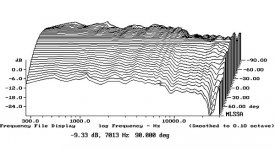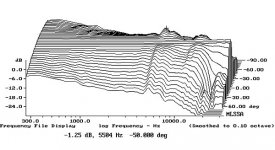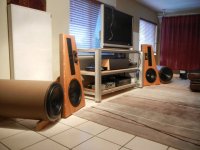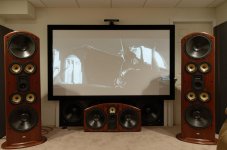With a 3 kHz crossover between the 7" midrange drivers and HF ribbons, there will be substantial lobing in the vertical and horizontal plane. I can only assume this is an intentional design feature on Bill Duddleston's part ... a way of narrowing directivity, perhaps?
Legacy Whisper specifications
A more detailed application appears in the steerable array of Legacy theater loudspeakers.
Legacy Whisper specifications
A more detailed application appears in the steerable array of Legacy theater loudspeakers.
Last edited:
Does anyone out there know what Bill Dudleston is doing with the bass alignment of the Whisper? It is a dipole, but what is he achieving with the second woofer behing the first?
Also, his woofers look more like the pro sound type without much excursion capability, but I keep reading on here that one must have high excursion to successfully have an open baffle. I have heard the Wisher twice and really liked the sound in the bass region.
Greg
When I measured the distortion on my dipoles I was surprised how quickly it got out of control. So doubling the number of cones will lower your distortion in a hurry.
This would make a neat cardioid if you made the back driver sealed and the front driver dipole. (*does* require EQ though.)
With a 3 kHz crossover between the 7" midrange drivers and HF ribbons, there will be substantial lobing in the vertical and horizontal plane. I can only assume this is an intentional design feature on Bill Duddleston's part ... a way of narrowing directivity, perhaps?
How do you know the xo, I can't find that anywhere? By the way their Aeris looks more potent as a dipole to me. One review says that it beats Whisper...
All this double/compound dipole bass discussion is just vague babble, unless somobody shows actual measurements. There are so many issues with dipoles in practice, that theoretization easily gets messed. When we say same or inveter plarity, we must notice that some speaers have the second driver turned over (reverse+reverse is onward) Most of the stuff at Legacy website is just marketing hype. They surely have some good ideas and heavy technology (Xilica dsp), but also many obvious flaws eg. baffle width preventing dipole radiation above some 600Hz for Whisper.
There is another thread somewhere about compound dipole bass array - and it really works. But in a very narrow band. Actually it is Olsen's 3rd order gradient radiation. It also has 12dB/oct bass roll-off instead of 6dB/oct for 2nd order dipole. A very spesific system.
Juha, check page 28 in the pdf eg 0, 3k, 10k
Funny it should read 32, 3k and 10k or should it read 32Hz, 1kHz, 3kHz and 10kHz?
The super tweeter looks exactly like the Airbourne RT-4001 with a larger 4" ribbon mated to it and crossed lower @1kHz. Mid crossed at 3kHz. ???
Funny it should read 32, 3k and 10k or should it read 32Hz, 1kHz, 3kHz and 10kHz?
The super tweeter looks exactly like the Airbourne RT-4001 with a larger 4" ribbon mated to it and crossed lower @1kHz. Mid crossed at 3kHz. ???
Last edited:
Legacy Whisper owner's manual http://www.legacyaudio.com/images/uploads/manuals/Whisper_XDS_Manual_1_28_14.pdf
Crossovers 200Hz, 3kHz, 10kHz
My my, but now I undertand why Bill Dudleston does not want to show polar responses! The manual gives good advice of how to set the processor as home tuning. I am happy to see Whisper uses B&O ICEpower amps and recommends REW
Crossovers 200Hz, 3kHz, 10kHz
My my, but now I undertand why Bill Dudleston does not want to show polar responses! The manual gives good advice of how to set the processor as home tuning. I am happy to see Whisper uses B&O ICEpower amps and recommends REW
Legacy Whisper owner's manual http://www.legacyaudio.com/images/uploads/manuals/Whisper_XDS_Manual_1_28_14.pdf
Crossovers 200Hz, 3kHz, 10kHz
My my, but now I understand why Bill Duddleston does not want to show polar responses!
The polar response at 3 kHz must be ... well, interesting, with the midrange drivers at least 7" center-to-center in the lateral plane, and I'm guessing 16" or more in the vertical plane. No amount of DSP processing is going to correct the multiple lobes in both planes.
Widely spaced drivers has been a Legacy design feature for at least twenty years, so Mr. Duddleston must like what it does to the sound. When a key design feature persists for that long, I can only assume it's a desired feature, and not an accident.
Same for Wilson, really. Even though the Focal inverted dome tweeter had many weak points ... short excursion, multiple in-band high-Q resonances, etc. ... Wilson stayed with the tweeter for more than fifteen years. There must have been something about it that Mr. Wilson liked.
Last edited:
Same for Wilson, really. Even though the Focal inverted dome tweeter had many weak points ... short excursion, multiple in-band high-Q resonances, etc. ... Wilson stayed with the tweeter for more than fifteen years. There must have been something about it that Mr. Wilson liked.
At least as far as the Watt/Puppy was concerned, it wasn't a bad solution - basically 3-9 kHz of a foil-diaphragm design (be it fiberglass or titanium) with its flat-damped surround which allows for good detail (..if at the expense of an increased resonant behavior - that's averaged-out in the plots below).
The real limitation has always been that basic "2-way" design regarding polar behavior and the mid-woofer's that he used, always with a corresponding loss in pressure due to narrowing directivity from the mid-woofer off-axis.
From the 3 to the 8:
Wilson WATT Series 3-Puppy 2 loudspeaker Measurements | Stereophile.com
Wilson Audio Specialties WATT/Puppy 7 loudspeaker Measurements | Stereophile.com
Really, the sound of the speaker is almost entirely the mid-woofer and how it reacted to the various changes to that "truncated pyramid" design.
Here is an older variant of the Whisper:
Legacy Audio Whisper loudspeaker Measurements | Stereophile.com
Pity there is no lateral response plot.
..like the Watt/Puppy though, the defining characteristic of this design will be those mid-woofers and their reaction to the baffle. In particular you'll hear a lot of "baffle" with this design, which would make it a good candidate for that thread on speakers that sound "BIG".
Old Whisper's 0-30¤ averaged response shows lack of power 2-4kHz and boosted highs - exactly or even worse that was expected by layout and xo (last link of Scott)
Sure this speaker has a sound signature!
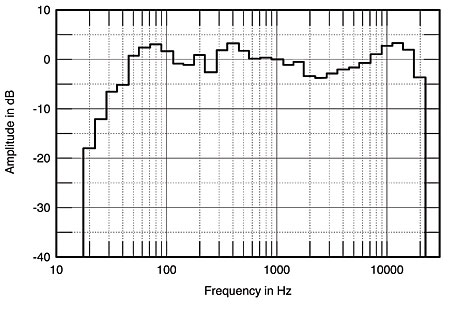
And room response alike (Actually this speaker sounds like it looks - huge bass and powerful mids, sharp highs! Very clever voicing, just what people generally want from a large speaker, makes marketing staff happy Listening comments of Stereophile support this)
Listening comments of Stereophile support this)
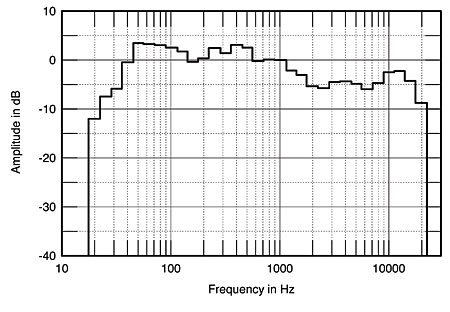
Ps. If someone here at diyadio would present something like this now, he/she would be laughed out! Poor us!
Sure this speaker has a sound signature!

And room response alike (Actually this speaker sounds like it looks - huge bass and powerful mids, sharp highs! Very clever voicing, just what people generally want from a large speaker, makes marketing staff happy

Ps. If someone here at diyadio would present something like this now, he/she would be laughed out! Poor us!
Last edited:
Ps. If someone here at diyadio would present something like this now, he/she would be laughed out! Poor us!
Actually, at the listening position (and general distance that was the listening position in these measurements), and as a range of axial averages - I doubt that many well-designed speakers (from their meter-design perspective) would fair much better.
Top-octave(s) loss is pretty common for point-source designs over increasing distance (..and increased with pressure loss off-axis due to source-diameter).
I wouldn't be at all surprised if upper-freq. waveguide designs have a similar midrange prominence when measured under a similar condition.
Last edited:
Stereophile liked this "modern" speaker very much and it measures like this:
Vivid Audio Giya G3 loudspeaker Measurements | Stereophile.com
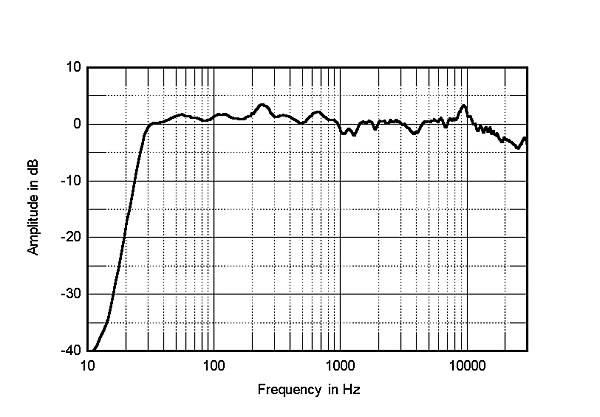
And this is their room response measurement of a waveguide speaker (red) http://www.stereophile.com/content/yg-acoustics-sonja-13-loudspeaker-measurements
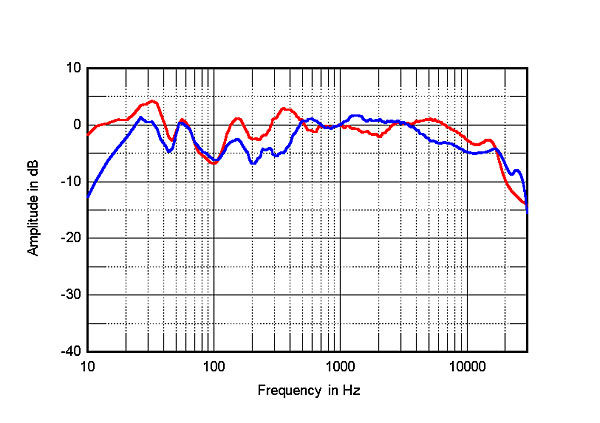
When I browse Stereophile's measurements and compare them to speaker layout, it is very difficult to see any kind of correlation. Commercial designs (even high-end) seem to have special voicing built-in. For examle a double-bass speaker has boosted bass vs. to it's single-bass sister. Waveguide 2-way vs regular 2-way usually have a difference. 3-ways can be anything. There are also simply terrible speakers around like this http://www.stereophile.com/content/zu-essence-loudspeaker-measurements
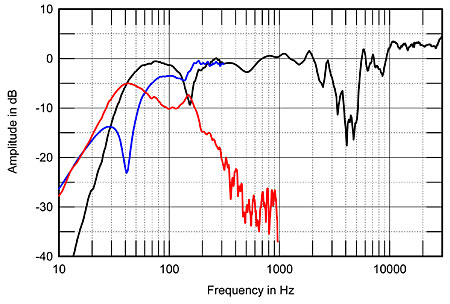
Vivid Audio Giya G3 loudspeaker Measurements | Stereophile.com

And this is their room response measurement of a waveguide speaker (red) http://www.stereophile.com/content/yg-acoustics-sonja-13-loudspeaker-measurements

When I browse Stereophile's measurements and compare them to speaker layout, it is very difficult to see any kind of correlation. Commercial designs (even high-end) seem to have special voicing built-in. For examle a double-bass speaker has boosted bass vs. to it's single-bass sister. Waveguide 2-way vs regular 2-way usually have a difference. 3-ways can be anything. There are also simply terrible speakers around like this http://www.stereophile.com/content/zu-essence-loudspeaker-measurements

Last edited:
Note: what I was referencing before was only the "listening position" measurements you displayed.
The problem with the "listening position" plot (and comparisons generally) is that there is no real "reference" - that grouping of positions, and most particularly the distance from the loudspeaker (and the loudspeaker's distance from walls), is unknown. In other words the listening position might only be 2 meters away in one example, and 4 meters in another example. Really, it's only there to give an idea of the freq. balance that subjective reviewer is experiencing (to better understand their impressions within the review).
My strong suspicion with the Whisper "listening position" plot is that the listening position is considerably further away from the loudspeaker than what you might see in other "listener position" plots.
Also note: the "waveguide" for the YGA speaker doesn't result in a great deal of pressure loss at even 60 degrees off-axis (or 120 degree window) when compared to the Vivid Audio loudspeaker (up to 8 kHz or so).
The problem with the "listening position" plot (and comparisons generally) is that there is no real "reference" - that grouping of positions, and most particularly the distance from the loudspeaker (and the loudspeaker's distance from walls), is unknown. In other words the listening position might only be 2 meters away in one example, and 4 meters in another example. Really, it's only there to give an idea of the freq. balance that subjective reviewer is experiencing (to better understand their impressions within the review).
My strong suspicion with the Whisper "listening position" plot is that the listening position is considerably further away from the loudspeaker than what you might see in other "listener position" plots.
Also note: the "waveguide" for the YGA speaker doesn't result in a great deal of pressure loss at even 60 degrees off-axis (or 120 degree window) when compared to the Vivid Audio loudspeaker (up to 8 kHz or so).
Attachments
As I read back over the subjective review and Dudleston's objectives.. it becomes clear that the design was intended to be placed closer to the corners of a room (..though not "Klipschorn" close).
Legacy Audio Whisper loudspeaker | Stereophile.com
The reviewer however had them 54" from the front wall..
Legacy Audio Whisper loudspeaker | Stereophile.com
The reviewer however had them 54" from the front wall..
Last edited:
Yes Scott i noticed that you meant room response, but Stereophile does shows them only sometimes. They are very difficult to compare, and therefore nowdays they show directivity measurements, which is better!
YGA Sonja is mtm with waveguide and has excellent constant directivity. Giya is very smooth but has different profile (rising directivity), since it does not have wg.
YGA Sonja is mtm with waveguide and has excellent constant directivity. Giya is very smooth but has different profile (rising directivity), since it does not have wg.
Wow...this thread has really wandered off the Whisper compound dipole bass configuration topic.
I found that each doubling of number of woofers(1 to 2, and 2 to 4) gave a +6dB increase in output.
I wonder if he means starting with the 2 front 15s, adding one rear 15 gives +3dB adding another gives you +6dB.
I believe this is what Legacy is doing in their Helix Model.
"To maintain a controlled radiation lobe, the 15” mid-bass are mounted in an “over and under” arrangement, with the center of the array being coincident with the tweeter. Most unusually, the upper 15” is dipolar (open air) while the lower 15” is sealed. The summation of the figure-of-eight and the spherical omni patterns result in a directional cardioid pattern well down to the room pressurization frequencies, where the sub takes over."
Do you have any measurements to share on this topic?
A few years back I took some measurements using 12" woofers comparing single, vs compound(in phase and Olson differential modes).
If anybody is interested I can attempt to track them down.
Like I said, it's been a few years, but If I recall correctly, these dipole arrays using minimal baffles didn't stray particularly far from theory once driver size was modeled.
I'd agree, if you are only planning on using it for the bottom couple octaves there are much better baffle configurations to improve output.Since I use a low crossover there is no significant benefit to my build it seems, though lack of cavity resonance is welcome.
Interesting...the most I ever experimented with was a stack of 4.in one of his whitepapers Duddleston said each additional 15" provided +3db of output. A one point he built a jig that allowed stacking of 8 drivers. Interesting but not too practical
I found that each doubling of number of woofers(1 to 2, and 2 to 4) gave a +6dB increase in output.
I wonder if he means starting with the 2 front 15s, adding one rear 15 gives +3dB adding another gives you +6dB.
This would make a neat cardioid if you made the back driver sealed and the front driver dipole. (*does* require EQ though.)
I believe this is what Legacy is doing in their Helix Model.
"To maintain a controlled radiation lobe, the 15” mid-bass are mounted in an “over and under” arrangement, with the center of the array being coincident with the tweeter. Most unusually, the upper 15” is dipolar (open air) while the lower 15” is sealed. The summation of the figure-of-eight and the spherical omni patterns result in a directional cardioid pattern well down to the room pressurization frequencies, where the sub takes over."
All this double/compound dipole bass discussion is just vague babble, unless somobody shows actual measurements. There are so many issues with dipoles in practice, that theoretization easily gets messed.
Do you have any measurements to share on this topic?
A few years back I took some measurements using 12" woofers comparing single, vs compound(in phase and Olson differential modes).
If anybody is interested I can attempt to track them down.
Like I said, it's been a few years, but If I recall correctly, these dipole arrays using minimal baffles didn't stray particularly far from theory once driver size was modeled.
"Do you have any measurements to share on this topic?"
No sir, sorry. I don't have any dipole bass speakers. But I have lots of measurements of my dipole speaker project in my own thread here http://www.diyaudio.com/forums/multi-way/231353-aino-gradient-collaborative-speaker-project.html
I decided to use monopole bass and cross over to dipole around 150Hz. A good dipole bass that can reach 90dB at 30Hz effortlessly are huge - I don't have room for them.
I have studied the work of Linkwitz, Kreskowsky and Kimmosto carefully, and followed several forums for the past 5-6 years. Based on all this I decided to stay monopole below room's Schroeder limit.
No sir, sorry. I don't have any dipole bass speakers. But I have lots of measurements of my dipole speaker project in my own thread here http://www.diyaudio.com/forums/multi-way/231353-aino-gradient-collaborative-speaker-project.html
I decided to use monopole bass and cross over to dipole around 150Hz. A good dipole bass that can reach 90dB at 30Hz effortlessly are huge - I don't have room for them.
I have studied the work of Linkwitz, Kreskowsky and Kimmosto carefully, and followed several forums for the past 5-6 years. Based on all this I decided to stay monopole below room's Schroeder limit.
Wow, I'm amazed my thread got drug up from the depths of the interwebs. In the intervening years, I've learned a ton, met Bill several times at shows and discussed topics with him at length. Each meeting I find him to be supremely knowledgeable about all matters of speaker design. His designs are some of the few higher end ones that I would consider purchasing if I were not such a DIY proponent. He runs the demos a little too loud for my tastes, but in general, set-up is excellent and my own refer material always sounds spot-on and neutral. Show after show, which is more than I can say for most other rooms.
My own system is open baffle, but I'd say not fully dipole. I progressively block rearward radition of the mids to better match the monopole nature of my tweeter. And I run sealed bass below about 80hz.
Greg
My own system is open baffle, but I'd say not fully dipole. I progressively block rearward radition of the mids to better match the monopole nature of my tweeter. And I run sealed bass below about 80hz.
Greg
Attachments
I don't have any dipole bass speakers. But I have lots of measurements of my dipole speaker project in my own thread here http://www.diyaudio.com/forums/multi-way/231353-aino-gradient-collaborative-speaker-project.html
Ok, thanks. Thought I'd ask since you had performed a lot of measurements in the past few years.
It does seem that many are migrating away from dipole bass for various reasons...me included.
Eh...what's a decade give or take, right?Wow, I'm amazed my thread got drug up from the depths of the interwebs.
Thanks for sharing your impressions of Legacy products and Bill Dudleston.
So, I have the Whispers
I have the Whispers and thought I would share my experiences with them at home and at audio shows.
My Whispers
I believe all the stuff like cardiod, nulls, interacting less with the room are marketing talk and Legacy should stop emphasizing that so much. It stretches credibility. They also have it so practiced that is sounds too rehearsed. The Whispers are so different from any other speaker they get asked hundreds of times a day on the design. The conventional wisdom is that the Whisper must have terrible comb filer, and phase coherence issues with all those drivers. Well I have measured mine extensively and the phase response appears great. The speakers completely disappear like they have nothing to do with the sound. I thought it was a crazy stupid design until I heard it in at good room environment and I forgot about all that conventional wisdom. Somehow Bill has tuned all those drivers to work together. The Stereophile review from a while back says the same thing. Legacy Audio Whisper loudspeaker | Stereophile.com
My whispers at home sound better than 99% of speakers at audio shows and 10x better than Whispers at the three audio shows where I have seen the them demoed. I would never have bought the Whispers if it was my only experience with them. It seems they really don't put effort into the placement of the Whispers for the shows. They just seem to plop them down at the sides of the table with no toe in. They put them too far apart, not angled right, not far enough out in the room. I just don't understand it. Dipoles are notoriously hard to setup right. 1/4 of an inch makes a difference. I think they should optimize for 6 seats and the show and make people sit there for the whispers. Instead then always get a big room with 20 chairs and it sounds so-so to my ears. They are indeed unbelievable speakers, but also hotels are HORRIBLE places to listen to speakers for many reasons and Legacy is not dealing with it and turning away discerning people.
Whispers were designed and tuned to have substantial toe it. More than any speaker I have seen. Bill tunes them while they are directly pointed right at him. He actually recommends crossing them over in front of your face.
The bass....It's dipole bass. Very low distortion, very quick, very subtle. You can tell if the drum is strung tightly type of bass. Problem with dipole bass is that it does not have the solar plexus punch than a woofer in a box does. That said, every time I listen, I am still very surprised how much bass it puts out for open-air woofers. It just does not seem possible. I listen both with and without subs.
The reason I have the Whispers is because they combine all that I love about speakers. I had Magnepans and loved the super quick ribbons and dipole sound stage. I had Martin Logan Odysseys and loved the super quick electro-stats and dipole sound stage. They did not have bass impact and could not play loud for home theater. Whispers have the ribbon quickness and air, the ability to play at rock concert levels, the dipole soundstage, and the non-boxy sound.
Audiophiles come over and can’t believe the sound that comes from them. I usually leave the grilles on until after they have listened to them a while and then they freak out when I take the grills off and ask the same questions as you hear at the shows – I just say – hey….. it works doesn’t it?
So Legacy must have done something right with their design……
I have the Whispers and thought I would share my experiences with them at home and at audio shows.
My Whispers
I believe all the stuff like cardiod, nulls, interacting less with the room are marketing talk and Legacy should stop emphasizing that so much. It stretches credibility. They also have it so practiced that is sounds too rehearsed. The Whispers are so different from any other speaker they get asked hundreds of times a day on the design. The conventional wisdom is that the Whisper must have terrible comb filer, and phase coherence issues with all those drivers. Well I have measured mine extensively and the phase response appears great. The speakers completely disappear like they have nothing to do with the sound. I thought it was a crazy stupid design until I heard it in at good room environment and I forgot about all that conventional wisdom. Somehow Bill has tuned all those drivers to work together. The Stereophile review from a while back says the same thing. Legacy Audio Whisper loudspeaker | Stereophile.com
My whispers at home sound better than 99% of speakers at audio shows and 10x better than Whispers at the three audio shows where I have seen the them demoed. I would never have bought the Whispers if it was my only experience with them. It seems they really don't put effort into the placement of the Whispers for the shows. They just seem to plop them down at the sides of the table with no toe in. They put them too far apart, not angled right, not far enough out in the room. I just don't understand it. Dipoles are notoriously hard to setup right. 1/4 of an inch makes a difference. I think they should optimize for 6 seats and the show and make people sit there for the whispers. Instead then always get a big room with 20 chairs and it sounds so-so to my ears. They are indeed unbelievable speakers, but also hotels are HORRIBLE places to listen to speakers for many reasons and Legacy is not dealing with it and turning away discerning people.
Whispers were designed and tuned to have substantial toe it. More than any speaker I have seen. Bill tunes them while they are directly pointed right at him. He actually recommends crossing them over in front of your face.
The bass....It's dipole bass. Very low distortion, very quick, very subtle. You can tell if the drum is strung tightly type of bass. Problem with dipole bass is that it does not have the solar plexus punch than a woofer in a box does. That said, every time I listen, I am still very surprised how much bass it puts out for open-air woofers. It just does not seem possible. I listen both with and without subs.
The reason I have the Whispers is because they combine all that I love about speakers. I had Magnepans and loved the super quick ribbons and dipole sound stage. I had Martin Logan Odysseys and loved the super quick electro-stats and dipole sound stage. They did not have bass impact and could not play loud for home theater. Whispers have the ribbon quickness and air, the ability to play at rock concert levels, the dipole soundstage, and the non-boxy sound.
Audiophiles come over and can’t believe the sound that comes from them. I usually leave the grilles on until after they have listened to them a while and then they freak out when I take the grills off and ask the same questions as you hear at the shows – I just say – hey….. it works doesn’t it?
So Legacy must have done something right with their design……
Attachments
- Status
- This old topic is closed. If you want to reopen this topic, contact a moderator using the "Report Post" button.
- Home
- Loudspeakers
- Multi-Way
- Legacy Whisper bass?
